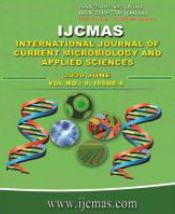


 National Academy of Agricultural Sciences (NAAS)
National Academy of Agricultural Sciences (NAAS)

|
PRINT ISSN : 2319-7692
Online ISSN : 2319-7706 Issues : 12 per year Publisher : Excellent Publishers Email : editorijcmas@gmail.com / submit@ijcmas.com Editor-in-chief: Dr.M.Prakash Index Copernicus ICV 2018: 95.39 NAAS RATING 2020: 5.38 |
A field experiment was conducted in Aeric Haplaquept to study the effect of Potassium and Zinc and interaction effect to increase the rice crop yield in Iron toxic soil. The experiment was conducted in RBD with three replications by taking rice Var. Jajati as a test crop. Twelve treatments combinations, consists of four levels of K (0, 40, 80 and 120 kg ha-1) and three levels of zinc (0, 2.5 and 5 kgha-1) were imposed on concerned plots with the recommended doses of N, P and K. The results showed that the highest rice yield of 42.2 qha-1 was found in the combined treatment of 80 kg K ha-1 with 5 kg Znha-1 (HI 46.4) which yield (40.1 qha-1) was statistically at par with the treatment of K40kgha-1 with Zn 5 kgha-1 (HI 46.2).. The mean rice yield was increased by 22 percent over control. Hence, it may be suggested to apply K40 kgha-1 + Zn 5 kgha-1 to get economically maximum benefit. Similar trends were observed in straw also. The concentration of iron in grain and straw was decreased with the treatments whereas Zinc and potassium concentration had an little influenced on grain and straw.
 |
 |
 |
 |
 |